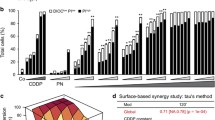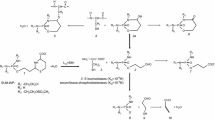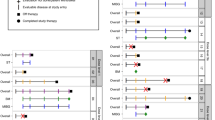Summary
In an effort to increase the efficacy of several antineoplastic alkylating agents (CDDP,l-PAM, CTX, or BCNU), we examined the effect of the modulator Fluosol-DA/carbogen in combination with a second modulator, either lonidamine or pentoxifylline, on the survival of FSaIIC tumor cells and of bone marrow CFU-GM from tumor-bearing C3H mice. Fluosol-DA/carbogen increased the tumor-cell killing activity of each alkylating agent by about 10 times. In contrast, lonidamine alone did not significantly increase the cytocidal activity of any of the alkylating agents tested. However, in combination with Fluosol-DA/carbogen, the use of lonidamine produced about a 100-fold increase in the tumor cell kill achieved with CDDP as compared with CDDP alone. No increase in tumor cell kill over that produced with the single modulator Fluosol-DA/carbogen was seen following the addition of lonidamine to the combination treatment withl-PAM, CTX, or BCNU. Unfortunately, although neither lonidamine nor Fluosol-DA/carbogen alone significantly increased alkylator toxicity to bone marrow CFU-GM, the combination of modulators increased the toxicity of each alkylating agent to bone marrow by about 10 times. Pentoxifylline caused an increase in alkylator activity against the FSaIIC fibrosarcoma only when used with BCNU; this effect was further augmented by the addition of Fluosol-DA/carbogen. The combination of modulators pentoxifylline plus Fluosol-DA/carbogen was more effective than Fluosol-DA/carbogen alone only when the former was used with BCNU, whereas only minimal increases in tumor-cell killing activity were obtained with this modulator combination and CDDP,l-PAM, or CTX. Pentoxifylline increased the bone marrow CFU-GM toxicity ofl-PAM by about 10 times. The bone marrow CFU-GM toxicity was further increased by Fluosol-DA/carbogen, as was the toxicity of each of the other alkylating agents. Lonidamine plus Fluosol-DA/carbogen may be useful in increasing the therapeutic efficacy of CDDP, and the combination of pentoxifylline plus Fluosol-DA/carbogen might improve the antitumor activity of BCNU.
Similar content being viewed by others
Abbreviations
- CDDP:
-
cis-diamminedichloroplatinum(II)
- l-PAM:
-
l-phenylalanine mustard, melphalan
- thioTEPA:
-
N,N′,N″-triethylenethio-phosphoramide
- CTX:
-
cyclophosphamide
- BCNU:
-
N,N′-bis(2-chloroethyl)-N-nitrosourea
- CFU-GM:
-
granulocyte-macrophage colony-forming unit
- αMEM:
-
alpha minimal essential medium
- PBS:
-
phosphatebuffered saline
References
Adams GE, Ahmed I, Sheldon PW, Stratford IJ (1984) Radiation sensitization and chemopotentiation: RSU-1069, compound more effective than misonidazole in vitro and in vivo. Br J Cancer 49:5571
Ambrus JL, Ambrus CM, Gastpar H (1979) Studies on platelet aggregation with pentoxifylline; effect on neoplastic disorders and other new indications. J Med 10:339
Aviado DM, Porter JM (1984) Pentoxifylline: a new drug for treatment of intermittent claudication. Pharmacotherapy 6:297
Bush RS, Hill RP (1975) Biologic discussions augmenting radiation effects and model systems. Laryngoscope 85:1119
Busse PM, Bose SK, Jones RW, Tolmach LJ (1977). The action of caffeine on X-irradiated HeLa cells: II. Synergistic lethality. Radiat Res 71:666
Busse PM, Bose SK, Jones RW, Tolmach LJ (1978) The action of caffeine on X-irradiated HeLa cells: III. Enhancement of X-ray-induced killing during G2 arrest. Radiat Res 76:292
DeMartino C, Battelli T, Paggi MG, Nista A, Marcante ML, D'Atri S, Malorni W, Gallo M, Floridi A (1984) Effects of lonidamine on murine and human tumor cells in vitro. Oncology 41 [Suppl 1]:15
DeMartino C, Malorni W, Accinni L, Rosati F, Nista A, Formisano G, Silvestrini B, Arancia G (1987) Cell membrane changes induced by lonidamine in human erythrocytes and T lymphocytes, and Ehrlich ascites tumor cells. Exp Mol Pathol 46:15
Dion MD, Hussey DH, Osborne JW (1989) The effect of pentoxifylline on early and late radiation injury following fractionated irradiation in C3H mice. Int J Radiat Oncol Biol Phys 17:101
Duncan W (1973) Exploitation of the oxygen enhancement ratio in clinical practice. Br Med Bull 29:33
Ehrly AM (1978) The effect of pentoxifylline on the flow properties of human blood. Curr Med Res Opin 5:608
Ehrly AM (1979) The effect of pentoxifylline on the deformability of erythrocytes and on the muscular oxygen presure in patients with chronic arterial disease. J Med 10:331
Evenson DP, Baer RK, Jost LK, Gesch RW (1986) Toxicity of thiotepa on mouse spermatogenesis as determined by dual-parameter flow cytometry. Toxicol Appl Pharmacol 82:151
Fingert HJ, Chang JD, Pardee AB (1986) Cytotoxic, cell cycle, and chromosomal effects of methylxanthines in human tumor cells treated with alkylating agents. Cancer Res 46:2463
Fingert HJ, Pu AT, Chen Z, Googe PB, Alley MC, Pardee AB (1988) In vivo and in vitro enhanced antitumor effects by pentoxifylline in human cancer cells treated with thiotepa. Cancer REs 48:4375
Floridi A, Lehninger AL (1983) Action of the antitumor and antispermatogenic agent lonidamine on electron transport in Ehrlich ascites tumor mitochondria. Arch Biochem Biophys 226:73
Floridi A, Paggi MG, D'Atri S, DeMartino C, Marcante ML, Silvestrini B, Caputo A (1981) Effect of lonidamine on the energy metabolism of Ehrlich ascites tumor cells. Cancer Res 41:4661
Floridi A, Paggi MG, Marcante ML, Silvestrini B, Caputo A, DeMartino C (1981) Lonidamine, a selective inhibitor of aerobic glycolysis of murine tumor cells. J Natl Cancer Inst 66:497
Floridi A, Bagnato A, Bianchi C, Paggi MG, Nista A, Silvestrini B, Caputo A (1986) Kinetics of inhibition of mitochondrial respiration by antineoplastic agent lonidamine. J Exp Clin Cancer Res 5:273
Fowler JR, Thomlinson RH, Howes AE (1970) Time-dose relationships in radiotherapy. Eur J Cancer 6:207
Fraval HNA, Roberts JJ (1978) Effects ofcis-platinum(II) diammine dichloride on survival and the rate of DNA synthesis in synchronously growing Chinese hamster V79-379A cells in the absence and presence of caffeine inhibited post replication repair; evidence for an inducible repair mechanism. Chem Biol Interact 23:99
Fraval HNA, Roberts JJ (1978) Effects ofcis-platinum(II) diammine dichloride on survival and the rate of DNA synthesis in synchronously growing HeLa cells in the absence and presence of caffeine. Chem Biol Interact 23:111
Geyer RP (1978) Substitutes for blood and its components. In: Jamieson GA, Greenwalt TJ (eds) Blood substitutes and plasma expanders. Alan R. Liss, New York, p 1
Hahn GM, vanKersen I, Silvestrini B (1984) Inhibition of the recovery from protentially lethal damage by lonidamine. Br J Cancer 50: 657
Hansson K, Kihlman BA, Tanzarella C, Palitti F (1984) Influence of caffeine and 3-aminobenzamide in G2 on the frequency of chromosomal aberrations induced by thiotepa, mitomycin C, andN-methyl-N-nitro-N′-nitrosoguanidine in human lymphocytes. Mutat Res 126: 251
Herman TS, Teicher BA, Holden SA, Pfeffer MR, Jones SM (1990) Addition of 2-nitroimidazole radiosensitizers to trimodality therapy (cis-diamminedichloroplatinum II/hyperthermia/radiation) in the murine FSaIIC fibrosarcoma. Cancer Res 50:2734
Hasegawa T, Rhee JG, Levitt SH, Song CW (1987) Increase in tumor pO2 by perfluorochemicals and carbogen. Int J Radiat Oncol Biol Phys 13:569
Kennedy KA, Teicher BA, Rockwell SA, Sartorelli AC (1980) The hypoxic tumor cell: a target for selective cancer chemotherapy. Biochem Pharmacol 29:1
Kennedy KA, Teicher BA, Rockwell SA, Sartorelli AC (1981) Chemotherapeutic approaches to cell populations in tumors. In: Sartorelli AC, Lazo JS, Bertino JR (eds) Molecular actions and targets for cancer chemotherapeutic agents. Bristol-Myers cancer symposia. Academic Press, New York, p 85
Kihlman BA, Anderson HC (1985) Synergistic enhancement of the frequency of chromatid aberrations in cultured human lymphocytes by combinations of inhibitors of DNA repair. Mutat Res 150:313
Lau CC, Pardee AB (1982) Mechanism by which caffeine potentiates lethality of nitrogen mustard. Proc Natl Acad Sci USA 79:2942
Muller R, Lehrach F (1981) Haemorheology and cerebrovascular disease; multifunctional approach with pentoxifylline. Curr Med Res Opin 7:253
Muller R, Schroer R (1979) Cerebrovascular circulatory disorders; new aspects of pathophysiology and therapy. J Med 10:347
Painter RB, Young BR (1980) Radiosensitivity in ataxia-telangiectasia: a new explanation. Proc Natl Acad Sci USA 77:315
Perego MA, Sergio G, Artale F, Giunti P, Danese C (1986) Haemorheological improvement by pentoxifylline in patients with peripheral arterial occlusive disease. Curr Med Res Opin 10:135
Poggesi L, Scarti L, Boddi M, Masotti G, Serneri GG (1985) Pentoxifylline treatment in patients with occlusive peripheral vascular disease. Angiology 36:628
Rice L, Urano M, Suit HD (1980) The radiosensitivity of a murine fibrosarcoma as measured by three cell survival assays. Br J Cancer 41:240
Rockwell S (1985) Use of perfluorochemical emulsion to improve oxygenation in a solid tumor. Int J Radiat Oncol Biol Phys 11:97
Rosbe KW, Bran TW, Holden SA, Teicher BA, Frei E III (1989) Effect of lonidamine on the cytotoxicity of four alkylating agents in vitro. Cancer Chemother Pharmacol 25:32
Sartorelli AC (1988) Therapeutic attack of hypoxic cells of solid tumors: presidential address. Cancer Res 48:775
Song CW (1987) Increase in pO2 and radiosensitivity of tumors by Fluosol-DA (20%) and carbogen. Cancer Res 47:442
Strano A, Davi G, Avellone G, Novo S, Pinto A (1984) Double-blind crossover study of the clinical efficacy and the hemorheologic effects of pentoxifylline in patients with occlusive arterial disease of the lower limbs. Angiology 35:459
Teicher BA, Holden SA (1987) A survey of the effect of adding Fluosol-DA 20%/O2 to treatment with various chemotherapeutic agents. Cancer Treat Rep 71:173
Teicher BA, Rose CM (1984) Perfluorochemical emulsion can increase tumor radiosensitivity. Science 223:934
Teicher BA, Rose CM (1984) Sensitization of solid mouse tumor to X-ray treatment by oxygen carrying perfluorochemical emulsion. Cancer Res 44:4285
Teicher BA, Rose CM (1986) Effect of dose and scheduling on growth delay of the Lewis lung carcinoma produced by the perfluorochemical emulsion, Fluosol-DA. Int J Radiat Oncol Biol Phys 12:1311
Teicher BA, Lazo JS, Sartorelli AC (1981) Classification of antineoplastic agents by their selective toxicities toward oxygenated and hypoxic tumor cells. Cancer Res 41:73
Teicher BA, Holden SA, Rose CM (1985) Differential enhancement of melphalan cytotoxicity in tumor and normal tissue by Fluosol-DA and oxygen breathing. Int J Cancer 36:585
Teicher BA, Holden SA, Rose CM (1986) Effect of Fluosol-DA/O2 on tumor cell and bone marrow cytotoxicity of nitrosoureas in mice bearing FSaII fibrosarcoma. Int J Cancer 38:285
Teicher BA, Lazo JS, Merrill WW, Filderman AE, Rose CM (1986) Effect of Fluosol-DA/O2 on the antitumor activity and pulmonary toxicity of bleomycin. Cancer Chemother Pharmacol 18:213
Teicher BA, Holden SA, Jacobs JL (1987) Approaches to defining the mechanism of Fluosol-DA 20%/carbogen enhancement of melphalan antitumor activity. Cancer Res 47:513
Teicher BA, Crawford JM, Holden SA, Cathcart KNS (1987) Effects of various oxygenation conditions on the enhancement by Fluosol-DA of melphalan antitumor activity. Cancer Res 47:5036
Teicher BA, Bernal SD, Holden SA, Cathcart KNS (1988) Effect of Fluosol-DA/carbogen on etoposide/alkylating agent antitumor activity. Cancer Chemother Pharmacol 21:281
Teicher BA, Herman TS, Rose CM (1988) Effect of Fluosol-DA on the response of intracranial 9L tumors to X-rays and BCNU. Int J Radiat Oncol Biol Phys 15:1187
Teicher BA, Holen SA, Cathcart KNS, Herman TS (1988) Effect of various oxygenation conditions and Fluosol-DA on the cytotoxicity and antitumor activity of bleomycin. J Natl Cancer Inst 80:599
Teicher BA, Holen SA, Crawford JM (1988) Effects of Fluosol-DA and oxygen breathing on Adriamycin antitumor activity and cardiac toxicity in mice. Cancer 61:2196
Teicher BA, McIntosh-Lowe NL, Rose CM (1988) Effect of various oxygenation conditions and Fluosol-DA on cancer chemotherapeutic agents. Biomater Artif Cells Artif Organs 16:533
Teicher BA, Holden SA, Al-Achi A, Herman TS (1990) Classification of antineoplatic treatments by their differential toxicity toward putative oxygenated and hypoxic tumor subpopulations in vivo in the FSaIIC murine fibrosarcoma. Cancer Res 50:3339
Author information
Authors and Affiliations
Additional information
This work was supported by National Cancer Institute grant IPO1-CA38493, by a grant from DeSanctis Consultants, Montreal, Canada, and by a grant from the Mathers Foundation
Rights and permissions
About this article
Cite this article
Teicher, B.A., Herman, T.S., Tanaka, J. et al. Fluosol-DA/carbogen with lonidamine or pentoxifylline as modulators of alkylating agents in the FSaIIC fibrosarcoma. Cancer Chemother. Pharmacol. 28, 45–50 (1991). https://doi.org/10.1007/BF00684955
Received:
Accepted:
Issue Date:
DOI: https://doi.org/10.1007/BF00684955




